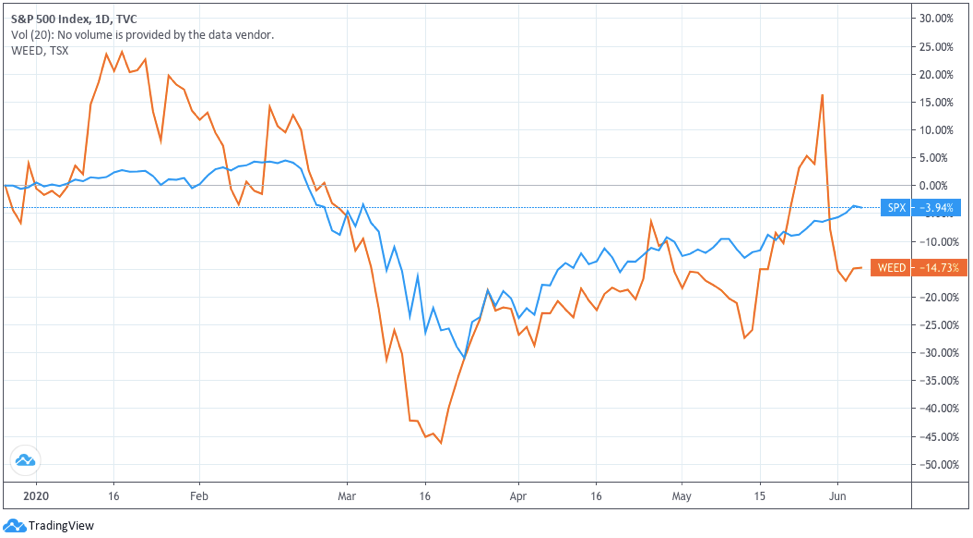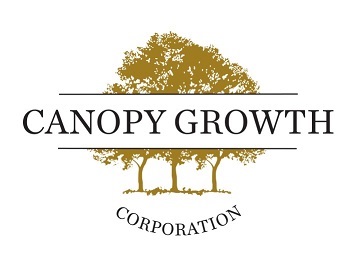In F2020, Canopy reported C$440 million in gross revenue up from $253 million in F2019. Net Revenue in FQ4/2020 was C$107.9 million down 13% from FQ3/2020, indicating a downward trend quarter-over-quarter. However, some of the decrease was the result of retail store closures, starting in mid-March due to the COVID-19 pandemic, which negatively affected sales.
According to Canopy’s annual financial report, as of May 29, 2020, many of their retail locations across Canada were reopen but with reduced hours and curbside pickup services. We expect these store closures could negatively affect sales in FQ1/2021.
CHART 1: S&P 500 vs Canopy Growth Corp., 1 Year Stock Performance

Canadian Cannabis Industry Trends
On the surface, the Canadian cannabis industry has experienced high demand growth, largely attributed to benefits of the recreational market’s legalization, which received approval at the end of 2018.
Last month, Trulieve Cannabis Corp. (CSE: TRUL) reported Q1/2020 earnings and beat analysts’ estimates by more than doubling its revenue year-over-year to US$96 million and other cannabis companies such as Aurora Cannabis (TSX: ACB) and Aphria Inc. (TSX: APHA), two of Canopy’s largest rivals, have also reported positive revenue growth.
However, the Canadian cannabis supply market expanded too quickly, as the industry forecasted anywhere from C$5 billion to C$10 billion in sales for last year, while only reaching actual sales of C$1.2 billion.
Canopy Top Line
 This past fiscal year, Canopy experienced significant top line revenue growth, primarily due to the legalization of the Canadian recreational market launching at the end of 2018, with F2019 capturing less than half the fiscal year’s worth of sales.
This past fiscal year, Canopy experienced significant top line revenue growth, primarily due to the legalization of the Canadian recreational market launching at the end of 2018, with F2019 capturing less than half the fiscal year’s worth of sales.
In F2020, Canopy reported C$440 million in revenue, with the recreational segment generating C$209 million, a 49% increase year-over-year, and the medical market generating C$125 million, a 58% increase year-over-year.
The majority of revenue in the recreational segment came from dry cannabis, which accounted for 88% of recreational sales, and the majority of revenue in the medical segment came from oils and softgels, which accounted for 71% of medical sales.
Canopy’s third revenue generating business, which mainly includes product sales from its vaporizer acquisition Storz & Bickle, reported C$106 million in revenue, a 210% increase year-over-year.
Canopy Bottom Line
In F2020, Canopy’s bottom line significantly deteriorated as it reported a Net Loss of C$1.3 billion, a 79% increase year-over-year, due to major restructuring in an effort to realign operations with re-adjusted demand forecasts.
Other restructuring measures included: (i) closing of production facilities, (ii) exiting out of non-strategic geographies, and (iii) rationalizing of marketing and research initiatives.
Canopy implemented restructuring initiatives, costing upwards of C$700 million, to readjust operations to appropriate demand forecasts. As a result, Canopy decreased production capacity in Canada by 40% and reduced headcount by 600 employees.
The restructuring hindered Canopy‘s ability to achieve profitability as the Company included C$132 million in charges, which increased the Cost of Goods Sold higher than top line revenues, even before adding in operating expenses.
Operating Expenses grew significantly to C$1.6 billion, a 146% increase year-over-year, due to C$694 million in SG&A costs, C$320 million in Share-based compensation, and C$623 million in Asset Impairment and restructuring costs.
In light of the pandemic and the overall future economic uncertainties, Canopy retracted its previous stated goals for short-term profitability and Canopy is taking time to further assess material impacts before announcing guidance for F2021.
However, Canopy remains confident it is in a stable position of liquidity and capital requirements, as it has C$1.3 billion in Cash and cash equivalents, C$673 million in short-term investments, and C$35 million remaining in its revolving credit facility.
//




